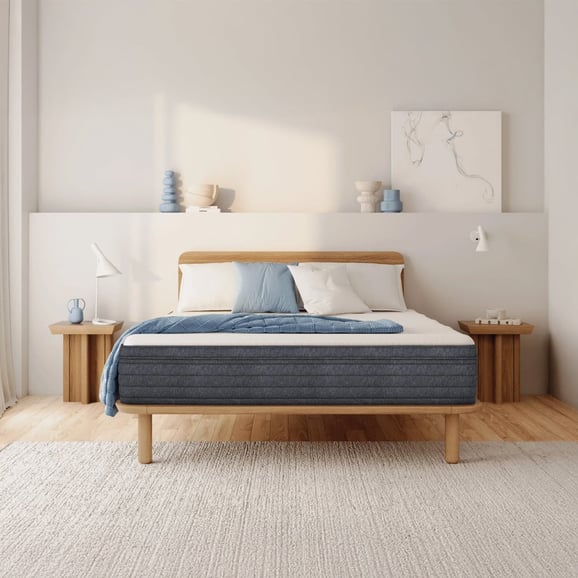When your mattress falls into the extremes of being excessively soft or overly firm, it can undeniably exert a substantial influence on the caliber of your sleep. However, there’s no need for distress, as we have a solution at your disposal! Through the process of fine-tuning and enhancing the comfort level of your mattress, you have the potential to elevate your sleep experience, ultimately awakening with a profound sense of revitalisation and renewed energy.
Determine Your Ideal Firmness Level
To fix a mattress that is either too soft or too firm , it’s essential to determine your ideal firmness level. This involves assessing personal preferences, sleeping positions, and understanding the impact of body weight on mattress firmness.
Assessing Personal Preferences and Sleeping Positions
When determining the right firmness level for your mattress, consider your personal preferences and sleeping positions. Do you prefer a soft, plush feel or a firmer surface? If you sleep on your side, you may benefit from a medium-firm mattress that provides adequate support while accommodating the curves of your body. Back sleepers typically enjoy a slightly firmer surface to maintain proper spinal alignment. Stomach sleepers often require a firmer mattress to prevent excessive sinking and maintain healthy posture.
Understanding the Impact of Body Weight on Mattress Firmness
Body weight plays an important role in choosing the right firmness level for your mattress. Heavier individuals may find that softer mattresses provide insufficient support and lead to discomfort or sagging over time. On the other hand, lighter individuals might not experience enough pressure relief on firmer mattresses. Consider how much you weigh when selecting a mattress with an appropriate firmness level.
Utilizing Online Resources and Tools for Guidance
Fortunately, there are various online resources and tools available to guide you in finding the ideal firmness level for your mattress. Many reputable mattress brands offer online quizzes or questionnaires that take into account factors such as sleeping position, body weight, and personal preferences to recommend suitable options. Customer reviews can provide valuable insights into how different firmness levels feel for people with similar needs.
Seeking Professional Advice from Mattress Experts
If you’re still unsure about which firmness level is best for you after utilizing online resources, consider seeking professional advice from mattress experts. Visit local bedding stores where knowledgeable staff can offer personalized recommendations based on your specific requirements. They can guide you through different firmness options, allowing you to test them out and make an informed decision.
Determining the ideal firmness level for your mattress is crucial in achieving a comfortable and restful sleep. By assessing personal preferences, understanding the impact of body weight, utilising online resources, and seeking professional advice, you can find the right firmness level that suits your needs.
Making a Firm Mattress Softer and More Comfortable
Adding a Plush Mattress Topper for Extra Cushioning
If your firm mattress is causing discomfort, one solution is to add a plush mattress topper. This extra layer of cushioning can provide the softness you desire without compromising the support of your bed. Look for a topper made with high-quality materials that offer pressure relief and contouring comfort.
Pros:
Provides additional plushness and comfort
Offers pressure relief and contouring support
Easy to install and remove as needed
Cons:
May not fully address the underlying firmness issue
Can sometimes impact the overall breathability of the mattress
Incorporating Memory Foam Layers to Enhance Softness
Another option to make your firm mattress softer is by incorporating memory foam layers. Memory foam conforms to your body shape, providing excellent pressure relief and added comfort. You can choose from various thicknesses and densities based on your preferences.
Pros:
Enhances softness and comfort
Offers exceptional pressure relief
Helps alleviate pain points during sleep
Cons:
Memory foam may retain heat, potentially causing discomfort for hot sleepers
Some individuals find memory foam too conforming or “sinking” feeling
Utilizing Adjustable Bases for Customizable Comfort
If you’re looking for customizable comfort, an adjustable base might be the answer. These bases allow you to change the incline or elevation of different sections of your bed, providing personalized support levels. By adjusting the position, you can make your firm mattress feel softer in specific areas.
Pros:
Allows customization according to individual preferences
Provides targeted support for different body parts
May help with conditions like acid reflux or snoring
Cons:
Adjustable bases can be expensive
Limited availability in some markets
Exploring Alternative Materials like Latex or Hybrid Mattresses
Lastly, consider exploring alternative mattress materials like latex or hybrid mattresses. Latex mattresses offer a balance of support and comfort, while hybrid mattresses combine the benefits of different materials. These options can provide a softer feel while still maintaining adequate support.
Adding a Mattress Topper for Extra Cushioning
Choosing the Right Type of Mattress Topper Based on Needs
When your mattress feels too soft or too firm, adding a mattress topper can be a game-changer. But with so many options out there, how do you choose the right one? It all depends on your needs and preferences.
Memory foam mattress toppers are great for pressure relief and contouring to your body shape.Latex mattress toppers offer excellent support and durability.
Featherbed or down-filled toppers provide a plush and luxurious feel.
Selecting Thickness and Density Options for Desired Comfort Level
The thickness and density of your mattress topper will determine the level of comfort it provides. Here’s what you need to know:
A thicker topper (around 3 inches) can transform a hard mattress into a cozy haven.
If you prefer a softer surface, opt for a lower density (around 3 pounds per cubic foot).
For those who want more support, higher density (around 4-5 pounds per cubic foot) is ideal.
Considering Cooling Features in Warmer Climates
If you live in a warmer climate or tend to sleep hot, look for cooling features in your mattress topper:
Gel-infused memory foam helps dissipate heat and keeps you cool throughout the night.Copper-infused foam has natural cooling properties that can regulate temperature.
Breathable materials like bamboo or cotton covers promote airflow and prevent overheating.
Maintaining Proper Hygiene by Regularly Cleaning the Topper
To ensure your mattress topper stays fresh and clean:
Follow the manufacturer’s instructions for cleaning.
Vacuum regularly to remove dust mites, dead skin cells, and debris.
Spot clean any stains promptly using mild detergent or upholstery cleaner.
Air out the topper occasionally by placing it in a well-ventilated area.
Remember, adding a mattress topper is an easy and cost-effective way to customize the comfort of your bed. It can make a world of difference in how you sleep and wake up feeling refreshed.
Adjusting the Room Temperature for Optimal Sleep
To fix a too soft or too firm mattress, it’s crucial to consider the impact of room temperature on sleep quality. The temperature in your bedroom can greatly affect your comfort level and overall sleep experience. Here are some key points to keep in mind:
Understanding the Effects of Temperature on Sleep Quality
The temperature of your sleeping environment can influence how well you sleep. When it’s too hot or too cold, it can be difficult to find a comfortable position and fall asleep. Extreme temperatures can also disrupt your sleep cycle, leading to restless nights and groggy mornings.
Using Fans, Air Conditioners, or Heaters as Needed
One way to adjust the room temperature is by using fans, air conditioners, or heaters depending on the season and personal preference. If you tend to get hot during the night, a fan or air conditioner can help circulate cool air and create a more pleasant sleeping environment. On the other hand, if you often feel chilly at night, using a heater can provide warmth and coziness.
Investing in Bedding Materials Suitable for Different Seasons
Another option is investing in bedding materials that are suitable for different seasons. For warmer months, lightweight and breathable fabrics like cotton or bamboo sheets can help regulate body temperature and prevent overheating. In colder months, thicker blankets or flannel sheets can provide extra warmth.
Experimenting with Temperature Settings Until Optimal Comfort Is Achieved
Finding the optimal room temperature may require some experimentation. Start by adjusting the thermostat to different settings each night until you find what works best for you. Pay attention to how your body responds to different temperatures and make adjustments accordingly.
By understanding the effects of room temperature on sleep quality and making necessary adjustments with fans, air conditioners/heaters, and bedding materials suitable for different seasons, you can ensure optimal comfort while fixing a too soft or too firm mattress.
Replacing the Foundation for Better Support
Signs of an Inadequate Foundation
If you find yourself sinking too far into your mattress or waking up with back pain, it may be a sign that your foundation is not providing enough support. Look out for sagging areas, uneven surfaces, or a lack of stability when you lay down.
Upgrading to a Sturdy Box Spring or Platform Bed Frame
Consider upgrading your foundation to a sturdier option like a box spring or platform bed frame. These provide better support and can help alleviate issues caused by a too soft or too firm mattress. A box spring consists of a wooden frame with springs inside, while a platform bed frame offers solid support through slats or a solid base.
Ensuring Proper Alignment Between Mattress and Foundation
To ensure optimal comfort and support, make sure that your mattress and foundation are properly aligned. If you have an adjustable base, adjust it to find the right position that suits your needs. For those using divan bases or bed frames, check if there are any loose screws or broken parts that might affect the alignment.
Checking Warranty Guidelines Before Making Changes
Before making any changes to your foundation, check the warranty guidelines provided by the manufacturer. Some warranties may require specific types of foundations to maintain the validity of the warranty. Make sure you understand these requirements before replacing or altering your current foundation.
By replacing an inadequate foundation with a sturdy box spring or platform bed frame, ensuring proper alignment between the mattress and foundation, and checking warranty guidelines beforehand, you can address issues related to having a too soft or too firm mattress effectively.
Achieving the Perfect Balance for Your Mattress
Congratulations! You’ve now learned how to achieve the perfect balance for your mattress. By determining your ideal firmness level, making a firm mattress softer, adding a mattress topper, adjusting the room temperature, and replacing the foundation, you can transform your too soft or too firm mattress into a comfortable haven for restful sleep.
Now that you have these valuable tips in your arsenal, it’s time to put them into action and experience the difference they can make in your sleep quality. Take charge of your comfort and create an environment that promotes deep relaxation and rejuvenation. Remember, a good night’s sleep is essential for overall well-being.
Sweet dreams await you!
FAQs
How often should I replace my mattress?
It is generally recommended to replace your mattress every 7-10 years. However, this timeframe can vary depending on factors such as the quality of the mattress and individual preferences. Keep an eye out for signs of wear and tear like sagging or discomfort that may indicate it’s time for a replacement.
Can I use multiple mattress toppers?
While using multiple mattress toppers is possible, it may affect the overall feel and support of your bed. It’s best to start with one high-quality topper that suits your needs before considering adding another layer. Experimenting with different combinations can help you find the perfect balance between comfort and support.
How do I know if my room temperature is affecting my sleep?
If you often wake up feeling too hot or too cold during the night or find it difficult to fall asleep due to discomfort caused by temperature, it may be an indication that your room temperature is impacting your sleep. Experiment with adjusting the thermostat or using bedding materials suitable for different seasons until you find what works best for you.
Is there any way to make a soft mattress firmer without purchasing a new one?
Yes! If you have a soft mattress that lacks the desired firmness, you can try adding a firmer mattress topper or replacing the foundation with a more supportive one. These simple adjustments can help enhance the overall feel of your mattress without the need for a complete replacement.
Can adjusting my room temperature really improve my sleep?
Absolutely! The ideal room temperature for sleep varies from person to person, but generally, a cool environment promotes better sleep quality. Experiment with different temperatures and bedding materials until you find what makes you feel most comfortable and relaxed during the night.
Sources:
https://www.mattressonline.co.uk/advice/how-to-make-mattress-firmer https://www.sleepfoundation.org/best-mattress/how-to-make-your-mattress-firmer














